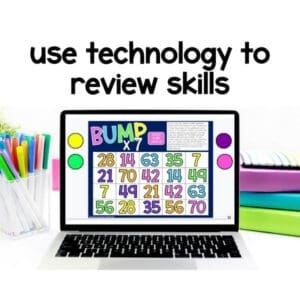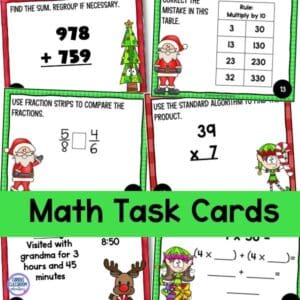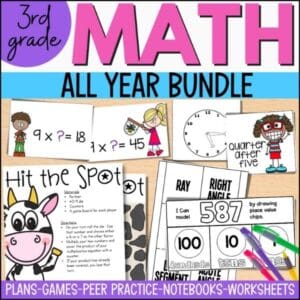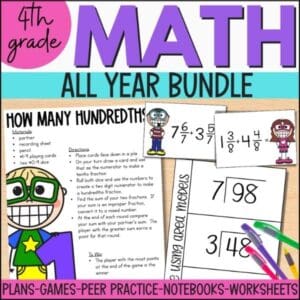Part of my daily relaxation habit is tackling a Sudoku puzzle…nerdy but true! I can easily spend 30 minutes diligently filling in numbers, and grappling with each square, row, and column. Suddenly, after what feels like an eternity, I will stumble upon that one elusive number that changes everything. Like a domino effect, the rest of the puzzle falls effortlessly into place. That aha moment? That’s the power of small group instruction for upper elementary math.
Just like finding that pivotal number in a Sudoku, small group instruction is the secret sauce that makes all the other pieces of math instruction fall seamlessly into place. It’s like having a tailored approach that meets each student right where they are, guiding them through a puzzle of mathematical concepts with care.
But don’t just take my word for it! Research consistently highlights the benefits of small group instruction for upper elementary students:
-
Increased Engagement:
Small group settings provide a supportive environment where students feel comfortable asking questions, sharing ideas, and actively participating in their learning journey. Research by Vygotsky emphasizes the importance of social interaction in cognitive development, underscoring the value of collaborative learning experiences.
-
Targeted Instruction:
With smaller groups, teachers can personalize instruction to address individual learning needs. According to a study by Hattie, small group instruction has a significant positive effect size on student achievement, indicating its efficacy in promoting learning gains.
-
Enhanced Understanding:
Small group settings allow for more opportunities for students to receive feedback and clarification. This fosters deeper understanding of mathematical concepts and promotes critical thinking skills. As noted in a meta-analysis by Slavin, small group instruction is associated with higher academic achievement across various subjects, including mathematics.
So, armed with this knowledge, how can you incorporate this game-changing strategy into your upper elementary math class? Fear not, because I’ve got your back with a simple yet effective system to make it happen.
Set the Stage for the Day with Review of a Known Skill and Introduce the New Skill.
Designing your math block around the power small group instruction doesn’t mean you don’t do anything as whole group. To activate students’ math muscles, start with something they already know, such as a quick review of what they learned yesterday or a spiral review of things you want them to keep practicing so they are sharp for those end-of-year standardized tests. Then do an introduction of the new skill you’ll be teaching that day by modeling the concept for everyone at the same time.
Now it’s time for the magic! Small group instruction.
In order to work with small groups, you’ll need to keep the rest of your class actively engaged in math learning while you work with small groups and set up a way for all of them to rotate to see you at some point during math block. That means you need work that the students who aren’t actively working with you can do independently. Math stations are perfect for this.
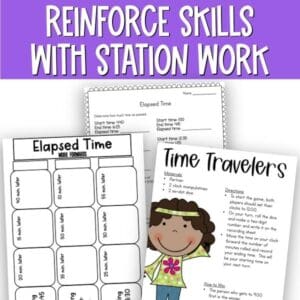
After much trial and error, I’ve found thinking about each math lesson as a two-day lesson that is always overlapping with the next lesson is the best way to solve this particular puzzle. Something like this….
- Day 1- independent review a known skill and introduce concept A and go deeper with small group instruction for concept A
- Day 2-independent practice for concept A. Introduce concept B and small group instruction for concept B.
- Day 3- independent practice for concept B. Introduce concept C and small group instruction for concept C.
Set a up System for Small-Group Rotations.
Here’s a snapshot of the math rotations I have found to be the most effective.
- Teacher Table (new skill): Provide targeted instruction on the new skill of the day with a “just right” amount of model and practice for that particular group. Keep a close eye on student progress and intervene as needed. That is one of the biggest benefits of small group instruction for math. It allows you to catch the errors students make before they become hard-to-break habits. You can also save yourself time later by grading student work on the spot with this FREE handy math rubric!
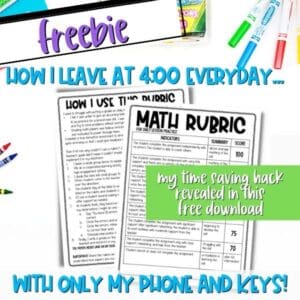
- Partner Games (previous skill): Foster friendly competition and exploration with math games that practice the skill you taught them yesterday. They already practiced and showed you that they understand this concept, so they are ready to work on it independently and cooperatively with peers. Encourage students to coach each other as they tackle math challenges together.
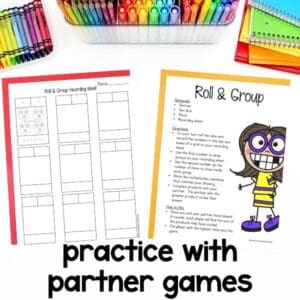
- Interactive Notebooking (previous skill): I love having students build a year long record of the math they are learning and interactive notebooks are prefect for this. When done well, interactive notebooks turn into evidence of learning for you and a reference tool for students.

- Technology, Task Cards, or Paper and Pencil (previous skill): Give your students some extra targeted practice by incorporating independent work. I like to switch it up depending on what resources I have for the skill. Sometimes I have a great app for the skill they are practicing, like the multiplication game below, and other times I want to give them a little more opportunity for kinesthetic learning by placing task cards around the perimeter of the room that are focused on the skill they learned the day before.
Once you’ve introduced the rotations for the day, it’s time to get to work. Assign everyone to their starting spots, set a timer, and start rotations.
Wrap up with Cooperative Learning Practice:
After you’ve had a chance to work with each group and they are feeling confident, let them show off what they’ve learned with a cooperative learning activity. Choose one of your favorite structures and a few math problems from the day.

While the whole class might be doing the same exercise at the same time, cooperative learning is really small group instruction, too! The only difference is the amount of independence students have to coach and teach each other. This is a great opportunity to walk around the room as students work with each other to eavesdrop on their math conversations and reap the rewards of your planning and direct instruction!
Small group math instruction….Try it, embrace it, and watch your students soar to new mathematical heights. To make it extra easy to plan and implement I’ve pulled together all my favorite resources in these full year bundles for 3rd grade math and 4th grade math.
Together, we’ve got this math puzzle in the bag. Now off to find my next sudoku!


